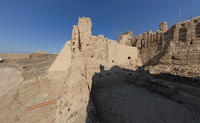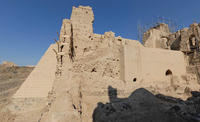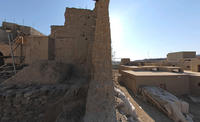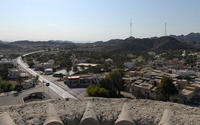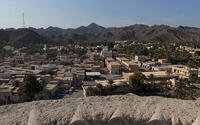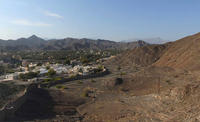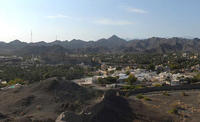You are in: Middle East -> Oman -> Bahla Fort, and traditional search or Image Gallery will yield results of this site only
Bahla Fort
| Site number: | 433 |
|
| Type of site: | Cultural | |
| Date: | 12-15th century | |
| Date of Inscription: | 1987 | |
| Location: | Middle East, Oman, Oasis of Bahla, 25 km West of Nazwa | |
Up to 75 images are shown here. Click on each for more details or on Image Gallery for more images.
| Description: | The roots of the prosperity of the oasis of Bahla stem from the Banu Nebhan, the dominant tribe in the area from the 12th to the end of the 15th century. With its unbaked brick walls and towers and its stone foundations, the ruins of the vast fortification is an incredible illustration of this kind of fort and demonstrates the power of the Banu Nebhan. --WHMNet paraphrase from the description at WHC Site, where additional information is available. For 360 degree imaging of this site, click here. | |
| Bahla Fort (Arabic: قلعة بهلاء; transliterated: Qal'at Bahla') is one of four historic fortresses situated at the foot of the Djebel Akhdar highlands in Oman. It was built in the 13th and 14th centuries, when the oasis of Bahla was prosperous under the control of the Banu Nebhan tribe. The fort's ruined adobe walls and towers rise some 165 feet above its sandstone foundations. Nearby to the southwest is the Friday Mosque with a 14th-century sculpted mihrab. The fort was not restored or conserved before 1987, and had fallen into a parlous state, with parts of the walls collapsing each year in the rainy season. The fort became a UNESCO World Heritage Site in 1987. It was included in the List of World Heritage Sites in danger from 1988. Restoration works began in the 1990s, and more than £6m were spent by the Omani government from 1993 to 1999. It remained covered with scaffolding and closed to tourists for many years. It was removed from the list of endangered sites in 2004. The Fort at Bahla, together with the nearby forts at Izki and Nizwa, and one further north at Rustaq, were centres of Kharajite resistance to the "normalisation" of Caliph Harun al-Rashid. The town of Bahla, including the oasis, suq and palm grove, is itself surrounded by adobe walls some 12 km long. The town is well known for its pottery. --Wikipedia. Text is available under the Creative Commons Attribution-ShareAlike License. For 360 degree imaging of this site, click here. | ||
| Source: | http://whc.unesco.org/en/list/433 | |
| Reference: | 1. UNESCO World Heritage Center, Site Page. | |














